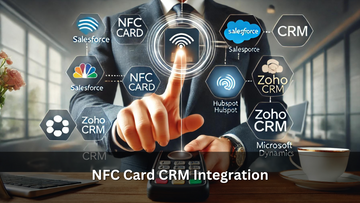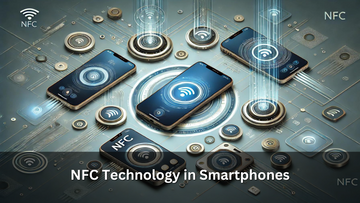Secure Authentication with NFC

Contents
- 1- Introduction to NFC Technology
- 2- How NFC Works for Digital Authentication
- 3- Benefits of Using NFC for Authentication
- 4- NFC and Biometric Integration
- 5- Real-World Applications of NFC in Digital Authentication
- 6- The Future of NFC in Digital Authentication
- 7- Custom NFC PVC Cards for Secure Authentication
Introduction to NFC Technology
Near Field Communication (NFC) is a short-range wireless technology that enables devices to exchange data when brought within a few centimeters of each other. Originally developed from radio-frequency identification (RFID) technology, NFC has become a cornerstone for secure, contactless transactions and data exchanges. This technology is widely used in applications such as mobile payments, access control, and digital identity verification. With its growing integration into smartphones and other devices, NFC is revolutionizing the way we interact with digital and physical environments, offering a seamless and secure user experience (NFC Forum)
How NFC Works for Digital Authentication
NFC technology operates by enabling two devices, typically a smartphone and an NFC-enabled tag or reader, to communicate when they are within close proximity, usually a few centimeters. For digital authentication, this process begins with the NFC device initiating a connection by generating a radio frequency field. When the NFC tag enters this field, it draws power from it to transmit its unique identifier and other encrypted data.
The authentication mechanism involves several steps:
- Initiation: The NFC-enabled device emits a radio signal.
- Data Exchange: The NFC tag responds with a unique identifier and encrypted data.
- Verification: The receiving device sends this data to a server, where it is decrypted and verified against stored information.
- Confirmation: The server sends back an authentication confirmation or denial.
This secure exchange ensures that the data cannot be easily intercepted or altered, making NFC a reliable method for secure transactions and identity verification (NFC Tagify)
Benefits of Using NFC for Authentication
NFC technology offers several advantages for digital authentication, enhancing both security and user convenience. One primary benefit is ease of use; NFC-enabled devices require only a simple tap or close proximity to initiate authentication, making the process quick and user-friendly. This simplicity significantly improves user experience, especially in comparison to traditional methods like passwords or PINs.
Another key advantage is enhanced security. NFC technology employs encrypted data transfer, ensuring that sensitive information is protected during transmission. Each interaction generates a unique code, making it difficult for unauthorized parties to intercept or replicate the data.
Versatility is another strength of NFC, as it can be integrated with other security measures such as biometrics. This combination allows for multi-factor authentication, further strengthening security.
Additionally, NFC's low power consumption and the widespread availability of NFC-enabled devices contribute to its practicality and scalability across various applications, from mobile payments to secure access control systems. These benefits make NFC a robust and flexible solution for digital authentication needs.

NFC and Biometric Integration
The integration of Near Field Communication (NFC) with biometric technologies represents a significant advancement in the realm of digital authentication. By combining the ease of NFC's contactless data transfer with the robust security of biometric identification, this synergy offers a highly secure and user-friendly authentication method. When a user taps an NFC-enabled device, such as a smartphone, against a reader, the device can transmit biometric data like fingerprints or facial recognition scans.
This process works by first capturing the biometric data, which is then securely stored and encrypted on the device. Upon tapping the NFC device, the stored biometric data is transmitted to a server for verification. This multi-factor authentication process ensures that only the rightful owner can access the system or perform a transaction.
The primary benefit of this integration is the added security layer biometrics provide, as biometric traits are unique to each individual and difficult to replicate. Additionally, this method streamlines the authentication process, making it faster and more convenient for users without compromising security. This combination is increasingly being used in applications such as mobile banking, secure access control, and identity verification systems, setting a new standard for secure and efficient authentication (NFC Tagify) (Bio Update) (Atera).
Real-World Applications of NFC in Digital Authentication
NFC technology has found diverse applications across various industries, enhancing security and convenience in digital authentication. One prominent use case is in mobile payments, where NFC enables contactless transactions through smartphones. Users can simply tap their phones on a payment terminal to complete purchases securely and quickly, as seen with services like Apple Pay and Google Wallet.
In the transportation sector, NFC is employed in contactless ticketing systems. Commuters can use NFC-enabled cards or smartphones to tap and gain access to public transit systems, reducing the need for physical tickets and streamlining the boarding process. Cities like London and Tokyo have successfully integrated NFC technology into their public transportation networks.
Access control is another critical area where NFC is making a significant impact. Secure facilities and offices use NFC-enabled ID cards or mobile devices to grant access to authorized personnel. This method is not only secure but also convenient, as it eliminates the need for physical keys or complex passwords.
The healthcare industry leverages NFC for secure patient identification and data access. Medical staff can use NFC-enabled devices to quickly access patient records, ensuring timely and accurate treatment while maintaining data security and privacy.
Additionally, consumer electronics benefit from NFC in pairing devices and sharing data. For instance, Bluetooth speakers and headphones can be paired with smartphones through a simple NFC tap, simplifying the user experience.
These real-world applications demonstrate the versatility and effectiveness of NFC in providing secure and efficient digital authentication solutions across multiple domains.
The Future of NFC in Digital Authentication
The future of NFC in digital authentication is poised to expand significantly, driven by continuous advancements in technology and growing demand for secure, contactless solutions. Innovations are likely to enhance NFC’s range, speed, and integration capabilities, making it even more versatile. One key development is the increase in NFC’s power capabilities, allowing for more robust interactions and enabling NFC devices to support more complex applications.
Emerging trends include the integration of NFC with advanced biometric technologies, creating multi-factor authentication systems that combine the convenience of contactless interactions with the heightened security of biometric verification. This combination is expected to become standard in sensitive applications such as banking, healthcare, and secure access control.
The expansion of the Internet of Things (IoT) also presents new opportunities for NFC. As more devices become interconnected, NFC will play a crucial role in ensuring secure communication and authentication between these devices, facilitating seamless interactions within smart homes, cities, and workplaces.
Moreover, advancements in machine learning and artificial intelligence will likely improve the security algorithms used in NFC technology, making it more resilient against emerging cyber threats. These innovations will position NFC as a cornerstone technology for secure, efficient, and user-friendly digital authentication solutions in the future.
Custom NFC PVC Cards for Secure Authentication
Custom NFC PVC cards offer a robust solution for secure digital authentication across various applications. These cards are embedded with NFC chips, enabling them to communicate with NFC-enabled devices through a simple tap. Businesses and organizations can personalize these cards with unique designs, logos, and additional security features, such as holograms or QR codes, enhancing both functionality and brand identity.
One significant advantage of custom NFC PVC cards is their durability. Made from high-quality PVC material, these cards are resistant to wear and tear, ensuring longevity even with frequent use. This makes them ideal for use as employee ID badges, access control cards, or membership cards in fitness centers and clubs.
In terms of security, custom NFC PVC cards can store encrypted data, which is securely transmitted during authentication processes. This reduces the risk of data breaches and unauthorized access. Moreover, combining NFC technology with biometric verification can further enhance security, ensuring that only authorized users can access sensitive information or secure areas.
Custom NFC PVC cards are also versatile and can be integrated into various systems, including payment terminals, public transportation networks, and secure building access points. This flexibility makes them a valuable tool for modern digital authentication needs, providing a seamless, secure, and user-friendly experience.










